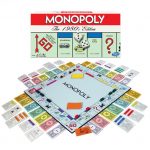
As we approach 2025, the world of board game manufacturing is undergoing a transformation that promises to be as exciting as a game of Catan during the final round. For board gamers and manufacturers alike, understanding these changes is as crucial as knowing the difference between a meeple and a pawn. This blog post will explore the innovative trends shaping the future of board gaming, offering insights and tips to stay ahead of the curve.
From advancements in technology to shifts in consumer preferences, the landscape of board game production is evolving. In this post, we’ll discuss how these changes affect both players and producers. Expect to learn about cutting-edge manufacturing techniques, the role of sustainability, and the growing influence of digital integration in tabletop games.
Let’s roll the dice and discover the future of board game manufacturing!
The Evolution of Manufacturing Technology
In recent years, the technological advancements in board game manufacturing have been nothing short of remarkable. With the advent of 3D printing, board game manufacturers can now create intricate game components with unprecedented precision. This technology not only speeds up production times but also allows for greater customization of game pieces, catering to niche markets and individual preferences.
Additionally, automation and robotics are streamlining the assembly process, reducing the need for manual labor and improving efficiency. This shift not only lowers production costs but also enables companies to scale their operations more effectively. Imagine a world where your favorite game can be produced faster than you can say “Monopoly”!
Furthermore, the use of artificial intelligence (AI) in design and prototyping is opening new doors for innovation. AI-driven software can analyze gameplay mechanics and suggest improvements, making the development process more dynamic and interactive. With AI as an ally, the possibilities for creating engaging and balanced games are virtually endless.
Sustainability Takes Center Stage
In today’s eco-conscious world, sustainability is no longer just a buzzword—it’s a necessity. The board game industry is no exception, with manufacturers increasingly adopting environmentally friendly practices. From using recycled materials to minimizing waste during production, companies are finding creative ways to reduce their carbon footprint.
Some manufacturers are even exploring biodegradable materials for game components, ensuring that your beloved titles don’t end up in a landfill once they’ve outlived their shelf life. This shift towards sustainability not only benefits the planet but also appeals to consumers who prioritize eco-friendly products.
Transparency in the sourcing of materials is another critical aspect of sustainable manufacturing. Companies are striving to provide information about their supply chains, giving consumers confidence that their purchases align with their values. By supporting brands that prioritize sustainability, board gamers can play their part in promoting a greener future.
The Rise of Digital Integration
While board games are inherently tactile experiences, the integration of digital technology is enhancing gameplay in exciting new ways. Augmented reality (AR) and virtual reality (VR) are revolutionizing the way players interact with their favorite games. Picture donning a VR headset and stepping into the world of your favorite RPG—it’s an experience that blends the best of both digital and physical gaming.
Digital platforms also offer opportunities for remote play, connecting players from all corners of the globe. Online communities and forums provide spaces for enthusiasts to share strategies, reviews, and fan-made content, fostering a sense of belonging and camaraderie.
Furthermore, companion apps are becoming popular additions to traditional board games. These apps can assist with rule clarification, track scores, and even introduce new gameplay elements, adding layers of complexity and enjoyment to standard offerings. The future of board gaming is one where technology and tradition coexist harmoniously.
Customization and Personalization
In an era where individuality reigns supreme, customization and personalization are key trends in the board game industry. Players crave unique experiences that reflect their tastes and preferences, and manufacturers are responding with bespoke options.
Gone are the days when every box contained identical components. Instead, players can choose from a range of customizable features, from personalized character cards to limited edition artwork. This level of personalization not only enhances the player’s connection to the game but also creates a sense of ownership and pride in their collection.
Crowdfunding platforms like Kickstarter have played a significant role in this trend, allowing creators to gauge interest and secure funding for personalized projects. Backers often receive exclusive content or early access to new releases, further fueling the desire for tailor-made experiences. The future of board gaming is one where players are active participants in the creation process.
Challenges and Opportunities in Global Distribution
Globalization presents both challenges and opportunities for board game manufacturers. On one hand, reaching international markets expands the potential customer base and increases revenue streams. However, navigating the complexities of global distribution requires careful planning and strategy.
Shipping costs, import taxes, and cultural differences are just a few of the factors that companies must consider when entering foreign markets. Building relationships with local distributors and understanding regional preferences are crucial steps in ensuring success abroad.
Despite these hurdles, the rewards of global expansion are significant. By tapping into diverse markets, manufacturers can gain valuable insights into consumer behavior and preferences, ultimately leading to more innovative and inclusive game designs. The world is a game board, and the opportunities for growth are endless.
The future of board game manufacturing is as dynamic and multifaceted as the games themselves. From technological advancements to sustainability initiatives, the industry is evolving to meet the demands of modern consumers. As we approach 2025, board gamers and manufacturers alike can look forward to a landscape filled with new possibilities and exciting challenges.



